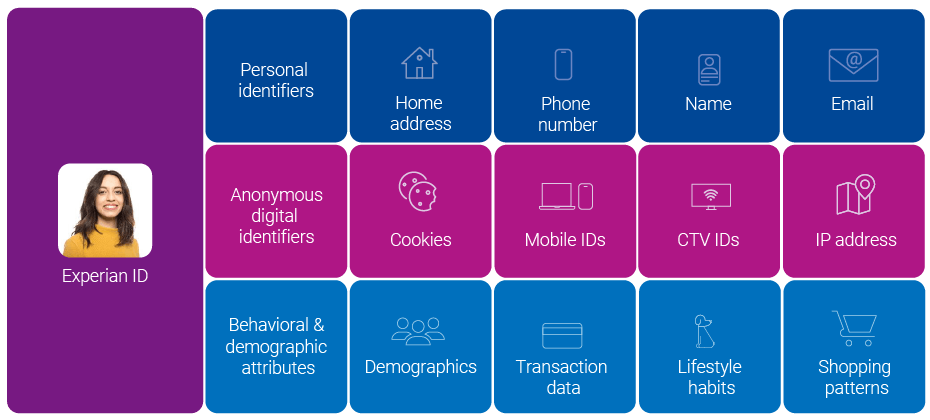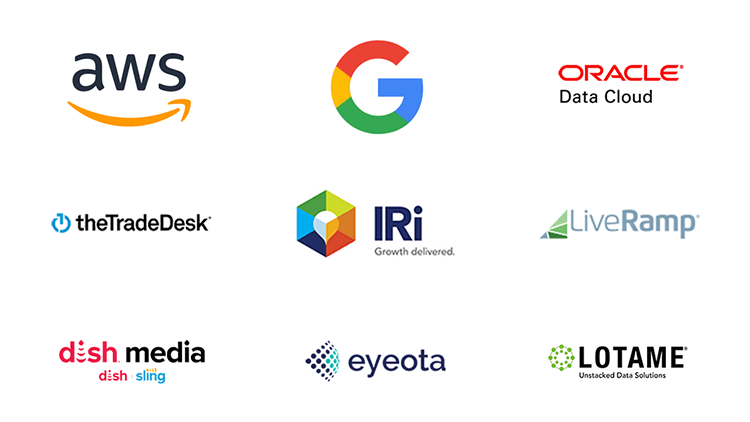Our guide to identity resolution
Understand identity resolution, discover its benefits, and learn how you can get started
The “unified consumer view,” also known as the “360-degree” or “connected customer view,” is an important topic of discussion in the marketing world today. It refers to the consolidation of customer data into a single unified record. Every marketer’s goal is to obtain a comprehensive consumer identity profile, but this is harder to achieve than it sounds. Marketers have access to more data than ever, and much of it is duplicate or inaccurate information. The deprecation of third-party cookies and increasingly strict data privacy legislation are also making it a challenge for marketers to obtain consumer identity data to inform their campaigns. Marketers must adapt to the future of advertising by finding ethical ways to navigate these new challenges or risk getting left behind. This is the importance of identity (ID) resolution.
We have compiled this guide to introduce you to the basics of identity resolution. We’ll help you understand how it can help your brand have more meaningful customer interactions. Let’s discover the way together.
Identity in marketing entails knowing who your customers are, including their needs, wants, and status in the customer journey. If you want to resolve the identities of your customers, you need to use data to link individuals and their online behavior across various touchpoints back to a single profile.
By connecting online and offline interactions across the internet, smartphone apps, emails, and more, you can build that coveted unified consumer view. This will enable you to connect better to a target audience and meet their needs.
Identity resolution begins in a consumer data platform that combines disparate data to complete the view of your customer. Identity resolution software has the capability to collect data from every type of environment — even those that are cookieless. The process involves the following core components:
Our hyperconnected world provides customers with countless ways to consume content and keeps them moving across channels and devices at a rapid pace. It can seem impossible to keep up with them to provide relevant messaging and brand experiences, but identity graphing simplifies this task.
An ID graph allows you to resolve fragmented information back to consumers and households. In doing so, the ID graph helps you understand linkages between devices and touchpoints by creating IDs that connect consumer identifiers and behaviors while maintaining the highest privacy standards. As a result, you’ll find it easier to provide a seamless, curated omnichannel experience for customers that drives loyalty and engagement while helping your business achieve its goals.
Identity resolution is a valuable practice that can help you understand your target audiences on a deeper level and customize your messaging to convert them and keep them coming back. We’ll discuss these benefits in more detail below.
If you get a lot of anonymous website visits, you might be tempted to ignore them and continue focusing on the customers you already have and know about. But if you ignore anonymous visitors, you miss out on valuable opportunities to get deeper behavioral insights and capture new audiences. Identity resolution allows you to link a user’s logged-out and logged-in activity into one profile. Without identity resolution, you wouldn’t be able to reconcile a user’s known and unknown website activity. Identity resolution unlocks a more comprehensive consumer view.
Shopping online isn’t usually a linear process. More often, potential customers interact with your business on their phones, computers, and in-person multiple times before making a purchase. That’s why it’s important to provide a cohesive brand experience. Instead of creating multiple identity profiles for the same person, identity resolution helps you recognize an individual across touchpoints and personalize their buying journey specifically for them so they have a consistently great experience.
When you use an identity resolution platform to understand your customers on a granular level, improve the accuracy of your targeting, and personalize their experience, you build trust with your audiences, which leads to loyalty and retention.
It’s not easy to win the loyalty of customers in today’s saturated markets. If you want to connect with them and build lasting brand relationships, you need the deep insights identity resolution can offer. What does the relationship with your customers look like? Next, we’ll talk about some of the most popular use cases and help you explore how identity resolution could work for you.
Without identity resolution, your consumers are reduced to a transaction or an ID. You won’t know anything about what that customer likes, what device they most commonly use, or anything else about them.
People use several devices to engage across different channels and touchpoints. It isn’t easy to associate a consumer identity with each of these devices.
When your brand doesn’t connect customer data to core identifiers, fragmentation occurs, which increases the number of irrelevant offers, decreases the quality of the customer experience, leads to unfocused campaigns, and wastes marketing dollars. One component of identity resolution involves the consolidation of first-party identifiers to improve your marketing performance.
Due to federal legislation, tech companies are cracking down on consumer privacy. Historically, cookies have helped marketers track users across browsers and devices so they could gain insights into customer behavior.
Cookies already don’t work on many handheld devices, but to complicate matters further, Google recently announced that it will eliminate third-party cookies for Google Chrome by late 2024. Without them, your organization will need to ramp up its identity resolution and data efforts to understand users.
Apple also plans to phase out its Identifier for Advertisers (IDFA) — and only 20% of its users currently choose to opt into it.
Not only are modern consumers demanding more control over the privacy of their data, but they are also beginning to expect marketing experiences customized to their needs and preferences.
It might seem like an impossible ask on the part of customers, but identity resolution is a simple way to respect their privacy while still giving them relevant ad experiences. Identity solutions enable you to collect data in a privacy-compliant way and use the resulting information to improve the customer journey and build trust with your customers.
Every device has a unique identifier, or anonymized data point, such as browser, IP address, browsing patterns, device type, or location data. This makes it exceptionally challenging to identify the same user across different devices.
Probabilistic matching uses multiple algorithms and sets of data to identify one user across applications and devices with a high level of probability; through statistical analysis, it matches multiple identity profiles that are most likely the same customer. If you end up with several records that appear similar and have linking identifiers but use different devices, it’s likely that this is the same individual.
Probabilistic matching is a useful tool for segmenting and targeting audiences, but this method is used when there is no common identifier, like social media or email, to connect a user to multiple devices.
Deterministic ID matching is usually the better approach to identity resolution because it uses first-party data that customers have produced — but it is possible only when first-party data is available. Through deterministic matching, you can merge your new data with customer records and identify matches among your existing identifiers. This high-confidence approach lets you be certain that an online action was taken by a particular identity.

For a successful identity resolution implementation, here are several decisions to make and actions to take in preparation for a new identity solution.
Your identity resolution strategy shows your company’s intention to become more focused on the customer by improving your capability to resolve identities and act on the insights you end up with. As you map the various aspects of your customer journey, you’ll be able to see where there are gaps and where you need to go with greater clarity.
It’s important to map the touchpoints along the customer journey so you can identify new opportunities to market to your audiences. Be sure to also map the customer’s digital and human encounters as well as the platforms and databases they interact with when building your strategy.
Remember that quality data is at the heart of identity resolution. Before you implement an identity resolution solution, make sure you aggregate your clean data in a safe, central location. Doing so will ensure better data management, collaboration, and accuracy.
The point of identity resolution is to create 360-degree consumer profiles and doing so requires a significant amount of data from many different sources. To begin compiling consumer profiles, you can turn to IP addresses, login data, and other such identifiers, but these are only a jumping-off point. You’ll also need to draw upon external sources of data to obtain external identifiers.
The more data sources you use, the more complete picture you’ll be able to paint of your target audiences.

More often than not, deterministic matching is the more favorable method. It provides up to 90% accuracy in matching an action to a user profile, but you will need first-party data already available to you to take this approach. If you have information gaps within your deterministic datasets, however, you can use a probabilistic approach to enrich the data and help you understand your audiences better.
Is your business prepared for a cookieless future? If not, don’t worry — Experian is a well-known identity resolution provider. We’ve helped countless companies future-proof their businesses with our identity resolution platform and world-class consumer data tools, and we’re ready to help guide you to the same success. Our software is an easy way to promote meaningful engagement with your customers in a way that respects their privacy and complies with regulations.
Contact us today to connect with one of our experts. No matter where you are in your identity journey, Experian can help. We’re here to help you achieve your marketing goals and put people at the center of your marketing.
We can help you create marketing strategies catered to the specific preferences and behaviors of your current and prospective customers. We specialize in helping brands discover data-driven insights to make an everlasting impact on consumers.
Our data and identity products and services can help you learn more about customers and target audiences, leverage data resources, improve targeted marketing, create personalized campaigns, and optimize marketing strategies.
With us, you’ll understand your consumers better, make more effective data-informed decisions, and increase your customer base for bigger revenue.

This site is protected by reCAPTCHA and the Google Privacy Policy and Terms of Service apply.